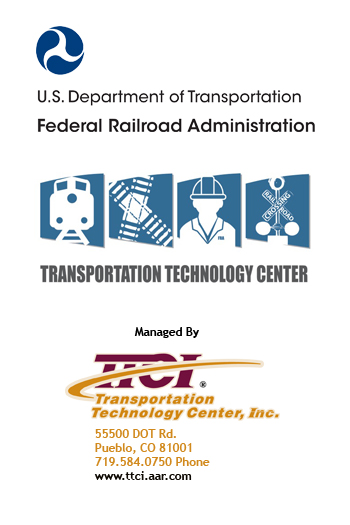Testing Facilities & Equipment
The R&D Facilities and Test Equipment Program addresses the acquisition, upgrading, and maintenance of FRA-owned facilities and equipment required to accomplish the whole spectrum of railroad research objectives and projects.
R&D Facilities
Transportation Technology Center
Mission

The Federal Railroad Administration (FRA) owns the Transportation Technology Center (TTC) in Pueblo, Colorado. The facility is on 52 square miles of land leased from the State of Colorado. Since its dedication as the High Speed Ground Test Center in 1971, it has played an important part in research, development, and testing of rail infrastructure and equipment including the Acela train prior to revenue service in 2000.
There are approximately 50 miles of test track at TTC. The short High Tonnage Loop is used primarily to test track components under heavy axle load freight cars. The 13.5 mile long Railroad Test Track is used for high-speed testing up to 165 mph. The shorter Transit Test Track is equipped with third rail electrification and a maximum speed of 90 mph. Various other test tracks are used to evaluate vehicle performance over a range of extreme track conditions.
The 12 major buildings at TTC include offices, workshops, test halls and laboratories. Test equipment includes servo-hydraulic stands on which entire rail cars can be mounted. There is a crash wall used for impact testing passenger cars and tank cars.
Since 1985, the Security and Emergency Response Training Center at TTC has been training first responders to handle hazardous materials accidents. In recent years the Transportation Security Administration (TSA) has created the Surface Technology Security Training Center located at TTC, providing training to Department of Homeland Security inspectors and other federal, state and local security partners. TSA’s presence is one of several cases of other Federal agencies using TTC. The Federal Transit Administration and the Department of Defense are also involved. Other government agencies are encouraged to use the facility.
TTC is managed under a unique Care, Custody, and Control contract with Transportation Technology Center, Inc. (TTCI). TTCI is a subsidiary of the Associations of American Railroads and serves member railroads through the AAR’s technology research program. Focused on enhancing railroad safety, reliability, and productivity, TTCI plays a worldwide role in the development and application of new technology for railways, suppliers, governments, and others involved in rail transportation. For more information please visit www.ttci.aar.com
R&D Test Equipment
With the initiation of higher speed service between Washington and Boston and the first issuance of track safety standards for speeds up to 200 mph, accurate parametric measurements which require sophisticated instrumentation have become critical for evaluating the track-train system performance. FRA acquired a Metroliner passenger car from Amtrak that was refurbished and equipped to meet these requirements. This car (T-16) allows the FRA to examine future high-speed corridors and routes that are intended for upgrading to higher maximum speeds. It also provides necessary monitoring and research at the high-speed test track at TTC, as well as in the Northeast Corridor and elsewhere in the country.
Gage Restraint Measurement System (GRMS) vehicle, T-18, is a performance-based rail restraint measurement car that locates track conditions of weak or failed rail restraint ability of the ties and fasteners to maintain gage under load. When the rail holding capacity of the ties and fasteners of a railroad track is exceeded by the forces generated by the train as it travels, the rails may move apart enough to allow the wheels to drop between the rails causing a “gage widening derailment”. The key to this performance-based approach was development of an index of Projected Loaded Gage (PLG), used to extrapolate the response of track to the heaviest credible loads from measurements of gage using lighter loads. The test load must be light enough to avoid track damage and derailment of the test car, but heavy enough to reveal weak track that allows gage to widen excessively. The GRMS vehicle utilizes this PLG index to determine the probability for derailment and mark the locations along the track where the extrapolated measurement exceed acceptable gage for the type of track tested. The GRMS vehicle eliminates a time-consuming and expensive visual inspection process that is subjective and not always accurate.
Recent enhancements to the DOTX218 include the installation of a Vertical Track Deflection Measurement System (VTDMS) that provides an indication of vertical displacement of the rail, which can then be translated into a measure of stiffness of the track bed. Ground Penetrating Radar (GPR) has also been demonstrated as viable system on the DOTX218 and is used to measure the amount of fouling, the presence of moisture, and layering of the track ballast section. In addition, the DOTX218 has been fitted with a state of the art LIDAR system that is used to profile and map the track bed as well as grade crossings. These new enhancements along with GRMS and the existing track geometry system, make the DOTX218 one of the most fully comprehensive research test vehicles in North America.
 Gage Restraint Measurement System (GRMS) Vehicle, T-18
Gage Restraint Measurement System (GRMS) Vehicle, T-18


